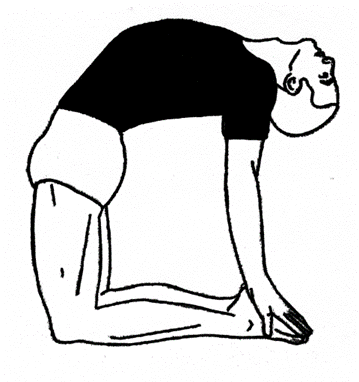Ushtrasana (Camel Pose)

Description
Ushtrasana, also known as Camel Pose, is a yoga posture that involves a deep backward bend of the spine, resembling the graceful arch of a camel’s back. This asana helps stretch the front of the body while providing various physical and spiritual benefits.
Execution
- Start by sitting in Vajrasana (Thunderbolt Pose).
- Stand on your knees with your arms at your sides.
- Keep your knees and feet together, although you can separate them if it’s more comfortable for you.
- Slowly lean backward, reaching for your right heel with your right hand and then your left heel with your left hand. Be cautious and avoid straining.
- As you reach for your heels, push your hips forward to maintain vertical thighs, and bend your head and spine backward as far as you can comfortably.
- Relax your entire body, especially the back muscles, as you settle into the stretch.
- Your body weight should be evenly distributed between your legs and arms. Your arms play a role in anchoring your shoulders to maintain the arch of your back.
- Hold the final position for as long as it feels comfortable.
- To return to the starting position, release your hands from your heels one at a time.
Breathing
Normal breathing is sufficient, as the chest is already stretched.
Duration
- Practice up to 3 times as a dynamic asana (with movement).
- Hold the final static position for up to 3 minutes.
Awareness
- Physical: Focus on the abdomen, throat, spine, or your natural breathing.
- Spiritual: Direct your awareness to Swadhisthana or Vishuddhi Chakra.
Sequence
- After performing Ushtrasana, it’s essential to follow it with a forward bending asana, such as Paschimottanasana (Seated Forward Bend), to release any tension in the back. Shashankasana (Hare Pose) is a suitable counterpose that can be performed directly from Vajrasana without unnecessary body movement.
Contra-indications
People with severe back ailments, such as lumbago, should avoid attempting Ushtrasana without the guidance of a competent yoga teacher.
Benefits
- Beneficial for the digestive and reproductive systems.
- Stretches the stomach and intestines, alleviating constipation.
- Loosens and stimulates the vertebrae and spinal nerves, relieving backache, rounded back, and drooping shoulders.
- Improves posture and opens up the front of the body.
- Tones organs in the neck region and regulates the thyroid gland.
- Can be helpful for people with asthma.
Variations
– Variation 1: Beginners can practice with the balls of their feet on the floor for added stability.
Variation 2: To intensify the pose, grasp your right heel with your left hand and your left heel with your right hand.
